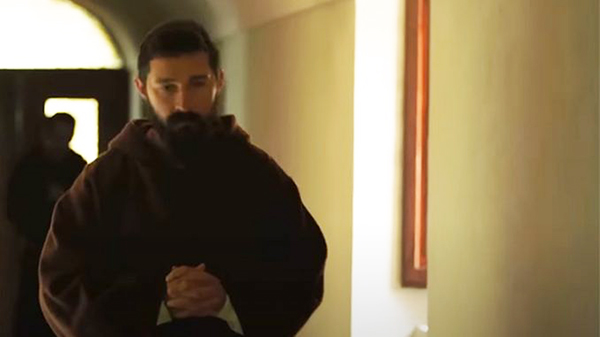'Padre Pio' suffers from disjointed narrative and troubling content
- KATHY SCHIFFER
Shia LaBeouf, who plays the famous saint in Abel Ferrara's Padre Pio, conveys a real reverence and an inspiring love, but cannot redeem questionable choices.
 Shia LaBeouf stars in Alex Ferrara's "Padre Pio." (Image: YouTube)
Shia LaBeouf stars in Alex Ferrara's "Padre Pio." (Image: YouTube)
If the prospect of a movie about Saint Pio of Pietrelcina, the stigmatist and saint popularly known as Padre Pio, excites you, you may be disappointed in the new docu-drama bearing his name. One hopes that moviegoers could find inspiration in the Capuchin friar's humility and his great love of God.
Sadly, director Abel Ferrara's Padre Pio is sometimes downright confusing, or worse.
When the docu-drama Padre Pio opened in theaters and via streaming on June 2, there was much positive to take away. St. Pio was indeed a holy man, and actor Shia LaBeouf, who plays the saint on the big screen, conveys a real reverence and an inspiring love. But viewers may be less than enamored of the production. First, the screen is so dark! The interior scenes, especially, recreating early 20th-century Italian homes, and the candlelit gatherings in the city, are murky and sometimes difficult to watch.
But more than the dark gloom there is a great darkness, an evil permeating the film, evident in the town, in the military, and even in Pio's struggles. One of the terrifying images used by the demon to invade Padre Pio's psyche involves a nude woman bathed in blue light. In the shocking scene, the naked woman sacrilegiously accosts a painting of the Virgin Mary. For this scene alone, some—including Catholic podcasters James Majewski and Thomas Mirus—say that Catholics should not watch the film.
There is also the strong language: The men of San Giovanni Rotondo, the women, the soldiers, the priests—even Pio himself—carelessly toss about the "F"-word. This, combined with the violence in Padre Pio's interaction with the demons, the nudity in one demonic temptation, and the bloody massacre of townspeople, earned the film's "R" rating.
Padre Pio is not, as its name implies, simply the story of the Italian saint. Rather, there are two stories, and the viewer is jerked back and forth between them.
First, there is the life of Padre Pio—from his arrival at the mountain monastery, to his earnest prayers, to his strident warnings to penitents who seek forgiveness for their sins. But there is the secondary story of the town of San Giovanni Rotondo. At the conclusion of World War I, the return of soldiers from the front brought joy to the townspeople or, in some cases, brought great sorrow when it was learned that loved ones had died in battle. Competing factions struggled for dominance in the Italian town, arguing for or against socialism and workers' rights. The fervor of the citizens is met with a strong resistance, and the ensuing bloody conflict costs the lives of thirteen citizens.
One can't help but recognize the struggle that draws the two stories together: Padre Pio's tormented spirit as he struggles with temptation, and San Giovanni Rotondo's conflicted citizens who are hoping to establish a new framework for their society. Some viewers have also cited a third struggle: the personal problems facing actor Shia LaBeouf, whose addiction to alcohol, conflicts within past romances, and ongoing brushes with the law reveal a troubled spirit. In a way, Padre Pio's story is LaBeouf's story; and one hopes that Shia will find the peace and love that God wishes for him.
There appears to be a relationship between the dual themes of the film. In one scene, Pio consoles a couple who have lost two sons in the war and who are struggling to find a reason to live. "Do not let Satan take advantage of your suffering," he warns them. "If you lift your spirit up in prayer, the Lord will show you the design he has for you." One wonders if he is speaking to Francesco or talking to himself.
But if the intent of the film is to merge these two stories into a meaningful dialogue about the life of Padre Pio, it fails. The connection is neither strong enough nor clear enough to achieve the desired effect. Rather, it comes off more as two stories under one title, with too little connection to make the approach intelligible or meaningful.
If you hope to walk away from this movie inspired or uplifted, you may be disappointed. But despite the film's multiple shortcomings, one can appreciate the opportunity to learn more about one of the most venerated saints of modern times, and about the history of a small European town in post-War Italy. And perhaps the most inspiring scene is at the end of the film, when Jesus' nail-pierced hand reaches affectionately over Padre Pio's shoulder. And Pio, empathetic as he reflects on the suffering which Christ endured, is himself marked by the stigmata.
 This is J. Fraser Field, Founder of CERC. I hope you appreciated this piece. We curate these articles especially for believers like you.
This is J. Fraser Field, Founder of CERC. I hope you appreciated this piece. We curate these articles especially for believers like you.
Please show your appreciation by making a $3 donation. CERC is entirely reader supported.

Acknowledgement
 Kathy Schiffer. "Padre Pio suffers from disjointed narrative and troubling content." Catholic World Report (June 4, 2023).
Kathy Schiffer. "Padre Pio suffers from disjointed narrative and troubling content." Catholic World Report (June 4, 2023).
Reprinted with permission from Catholic World Report.
The Author
Kathy Schiffer is a Catholic blogger. In addition to her blog Seasons of Grace, her articles have appeared in the National Catholic Register, Aleteia, Zenit, the Michigan Catholic, Legatus Magazine, and other Catholic publications. She's worked for Catholic and other Christian ministries since 1988, as radio producer, director of special events and media relations coordinator. Kathy and her husband, Deacon Jerry Schiffer, have three adult children.
Copyright © 2023 Catholic World Report

